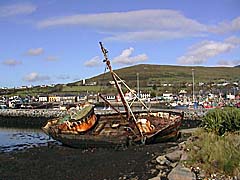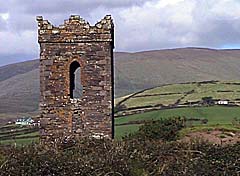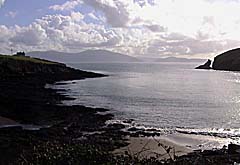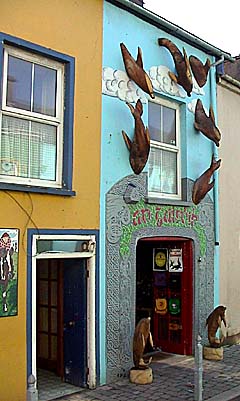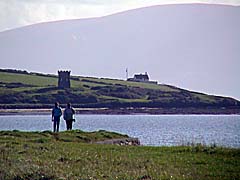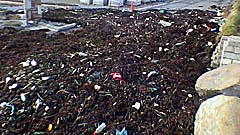
Week 3, part 5
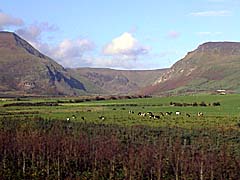 The mountains of the Dingle Peninsula as seen from our bus window on the way to Dingle town.
This wrecked fishing boat rests outside the Dingle marina.
In one particular way, Ireland looks a lot like Wisconsin.
The old Dingle watch tower, as seen from the top of the cliffs overlooking the harbor entrance.
The entrance to Dingle Harbor, as seen from the old watch tower.
|
Tralee is a city with few redeeming qualities except for its proximity to Dingle. We were advised to stay further north in Listowel, and we'd have loved to have stayed in Dingle itself, but the bus schedules would not permit us to reach our ferry to France on time unless we stayed in Tralee. We had a very nice room in Tralee with kind hosts, but the rest of town had all of the drawbacks of a poorly-planned crossroads town. There was no pedestrian zone as there was in Galway, and the traffic though the central city was relentless. The narrow sidewalks (called walkways here) were overrun with winos, bums, and bratty kids. An annoyance that so far has been common throughout Europe was particularly acute in Tralee. It's hard to get your hands on a local street map, and when you do, it's largely useless because the streets are so poorly marked that it's hard to figure out where you are even if you have a map. Most walkways are so narrow that two people can't walk side-by-side, and the walkways must handle two to three times the traffic of their American counterparts. Crosswalks as we know them are quite rare, so crossing the busy streets can often be a risky proposition. And we have yet to see a village or a city that is laid out in the rectangular grid familiar in American cities ... nearly every city street and country lane meanders in random directions. While this enhances the aesthetics of the area, it makes it easy to get lost. The tip of the Dingle Peninsula is the western-most point in Europe. The town of Dingle is about 20 miles short of that point, about an hour and a quarter by bus from Tralee. We made the trip on Saturday, and got to spend about 4 hours in Dingle. Historically, Dingle is a fishing town on a large natural harbor. We asked a couple of the fishermen what they fish for, and the answer was pretty much "whatever falls into the net, whatever's saleable." Most people come to Dingle to see Funghi, a dolphin who inhabits the entrance to the bay. The way the guide books talked about him, we practically expected to see Flipper dancing around on the water greeting the tourists along the waterfront. Reality is quite different. There are two ways to see Funghi. You can spend 7 punts to ride a "dolphin watching" boat, or you can take a hike to the cliffs overlooking the entrance to the bay and watch for him from there. Being that we were blessed with another perfect day, we opted to take the hike. We hiked to an old stone watchtower about a mile from town, where we sat down for our picnic lunch. Along the shoreline, anglers were lined up to see what they could catch. We watched a team of rowers go from town to the bay entrance and back. We listened to the waves crash against the shore below us after passing through the gap in the cliffs. And through that gap, an occasional fishing boat would make its way back into the harbor, and alongside one of those boats we saw a dolphin come up for air ... Funghi! Knowing where to look, we kept our eyes fixed on that area of the bay, and from time to time we'd see Funghi come up. Meanwhile, the tour boats roared in and out of the harbor, searching for the elusive dolphin. By the time we started back toward town, there were two of them, teaming up to herd Funghi into the lenses of their passengers' cameras. That's when we knew we had made the right choice ... we were glad not to have subsidized the harassment of this legendary creature. Just as we Americans don't have a monopoly on ugly suburbs, we also don't have a monopoly on trashy litterbugs. On every walking trail, we found a never-ending supply of empty plastic water bottles, food wrappers, and assorted McRubbish. On one particular spot on the Dingle shoreline we found a massive pile of seaweed washed ashore, with an equal amount of garbage mixed in. We've found trash in the deepest reaches of the forest, and we've found trash on park benches literally next to trash cans. If it can be carried in, it can be carried out. There's absolutely no excuse for this.
|
 Funghi the dolphin escorts a solo fisherman back into Dingle Harbor.
This storefront in Dingle was graced with likenesses of Funghi carved in wood.
A pair of hikers walk along the waterfront, with the old Dingle watch tower and the more modern light house in the background.
Not everything we've seen has been green and beautiful, as this trash washed up on the shore illustrates.
|
Next page ... Previous page
week 3 index
purplearth 2001 europe oddyzee index
purplearth home
